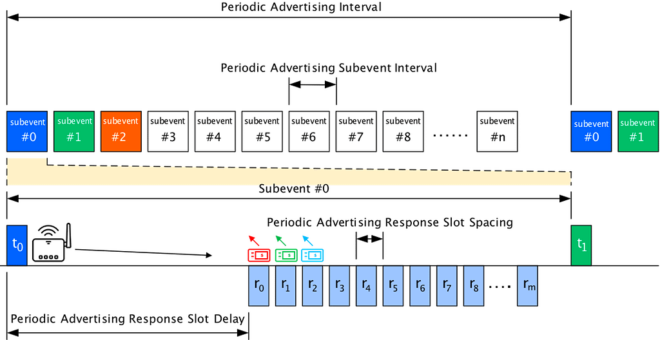
Electronic shelf labels (ESL) have been on the market for over two decades, evolving from basic LCD displays with limited pricing and product information towards higher quality, multi-functional IoT platforms capable of enabling several customer-facing and back-end operational benefits simultaneously. Despite the enormous potential addressable market of tens of billions of labels across retail, warehouse, healthcare, and many other environments, ESLs have thus far been unable to reach their true market potential.
Arguably, the biggest factor in this limited penetration has been the fragmented nature of the ESL market, which is comprised of a wide range of incompatible solutions and the lack of a unifying ESL standard. Many retailers have therefore been hesitant to adopt ESL solutions due to resulting concerns over vendor lock-in and no multi-vendor interoperability. This has limited their desire to deploy ESLs across all their stores and deploy additional smart retail use cases over time.
“Retailers are increasingly looking towards Internet of Things (IoT) technologies to help them deliver operational efficiencies, increase conversion, and to encourage customers to return to stores,” said Andrew Zignani, research director at ABI Research. “However, some retailers have been hesitant to adopt ESL technologies due to concerns over vendor lock-in, interoperability, scalability, and the ability to extend this to other smart retail initiatives.”
Recently, the Bluetooth Special Interest Group (SIG) commissioned ABI Research – a global leader in analyzing, tracking, and forecasting the transformation of the smart device and IoT markets – to explore the potential demand for ESL standardization.
![]()
FEATURED REPORT
How the Bluetooth® Electronic Shelf Label Standard Will Impact the Smart Retail Market
ABI Research explores how the recent arrival of the new Bluetooth® Electronic Shelf Label (ESL) standard will help create an interoperable ESL ecosystem that can address many of the challenges being faced by retail and other environments.
Market Demand for ESL Standardization
There are tens of billions of paper labels globally that could be replaced with Bluetooth Electronic Shelf Labels (ESL), representing an enormous addressable market. However, by the end of 2022, ABI Research estimates that the installed base of ESLs reached 788 million units. This means that the ESL market has barely scratched the surface of its true market potential. One of the major reasons for this has been ESL market fragmentation.

At the same time, some retailers have held back in adopting ESL and retail IoT technologies for fear of a technology becoming obsolete or the promise of something better in the future. The need to deploy multiple infrastructures, concerns over interoperability, security and privacy concerns, the need to support a long-term retail strategy, and a lack of education or complexity in deployment or maintenance are further barriers.
With many ESL vendors reporting record revenue over the last few years, ESL is clearly poised to become a fundamental component of future retail store digitization, enabling better customer engagement and experiences, local fulfillment, greater store automation, more efficient operations, and more frictionless checkout experiences. However, as successful large-scale smart retail deployments increasingly rely on interoperability, information gathering, and sharing across many different use cases, retailers will need to avoid siloed solutions that are incapable of working effectively with each other and will increasingly look towards open and modular platforms enabled by open standards. This will enable ESLs to become just one part of a wider smart retail wireless network that is able to aggregate and analyze data from several different use cases and devices to generate more intelligent insights and services. To achieve this and to accelerate this market further, large retailers demanded the standardization of ESL technology to better deliver simple-to-deploy, low-cost, low-power, interoperable, highly secure, and future-proof ESL solutions that are available from multiple vendors and capable of delivering on multiple use cases.
One technology that has delivered a standards-based approach to the ESL and smart retail market is Bluetooth® technology.
FEATURED INNOVATION
Bluetooth Electronic Shelf Labels (ESL)
With the introduction of a wireless standard for the electronic shelf label (ESL) market, Bluetooth® technology is helping unlock the next chapter in in-store digital transformation to deliver better retail outcomes for both stores and shoppers.
The Bluetooth Electronic Shelf Label Standard
In early 2023, the Bluetooth Special Interest Group (SIG) announced the release of the new wireless standard for the ESL market. The intention was to create a scalable, low-power, secure ESL standard that can enable the ESL market to reach its full potential. The Bluetooth® ESL standard leverages key new feature enhancements introduced in Bluetooth Core Specification Version 5.4, including Periodic Advertising with Responses (PAwR) and Encrypted Advertising Data, to deliver secure and scalable ESL deployments required by the ESL market.
“The introduction of the Bluetooth® ESL standard will help reduce potential obstacles for retailers looking to invest in IoT technologies and accelerate adoption and innovation.”
– Andrew Zignani, ABI Research
Establishing a true, global ESL standard gives retailers the freedom and confidence to source ESL components from multiple vendors knowing each will work with the others. “The introduction of the Bluetooth® ESL standard will help reduce potential obstacles for retailers looking to invest in IoT technologies and accelerate adoption and innovation,” said Zignani. Backed by a proven product qualification program, Bluetooth® ESL is the standardized solution the market has needed to minimize barriers to adoption and build a frictionless, interoperable ESL ecosystem.
To learn more, read the full report: How the Bluetooth® Electronic Shelf Label Standard Will Impact the Smart Retail Market. This report explores how the recent arrival of the new Bluetooth ESL standard will help create an interoperable ESL ecosystem.
![]()
FEATURED REPORT
How the Bluetooth® Electronic Shelf Label Standard Will Impact the Smart Retail Market
ABI Research explores how the recent arrival of the new Bluetooth® Electronic Shelf Label (ESL) standard will help create an interoperable ESL ecosystem that can address many of the challenges being faced by retail and other environments.
 電子棚札(ESL)は20年以上前から市場に存在する技術です。価格や商品情報のみを表示する当初のシンプルなLCDディスプレイから、より高品質で多機能なIoT (モノのインターネット) プラットフォームへと進化を遂げ、顧客対応とバックエンド業務におけるメリットの両立を実現してきました。ESLの潜在市場(Potential Addressable Market、PAM)は小売や倉庫、ヘルスケアをはじめ多くの分野にまたがり、ラベル数百億枚にも相当する膨大な規模と考えられていますが、現状ではその真の市場可能性の実現には遠く及びません。
電子棚札(ESL)は20年以上前から市場に存在する技術です。価格や商品情報のみを表示する当初のシンプルなLCDディスプレイから、より高品質で多機能なIoT (モノのインターネット) プラットフォームへと進化を遂げ、顧客対応とバックエンド業務におけるメリットの両立を実現してきました。ESLの潜在市場(Potential Addressable Market、PAM)は小売や倉庫、ヘルスケアをはじめ多くの分野にまたがり、ラベル数百億枚にも相当する膨大な規模と考えられていますが、現状ではその真の市場可能性の実現には遠く及びません。
普及が進まない最大の要因は、おそらくESL市場の細分化にあります。すなわち、互換性のないさまざまなソリューションの乱立と、統一的なESL規格の欠如です。多くの小売業者が、市場の細分化に伴うベンダーロックインや、複数のベンダー間の相互運用性の欠如を懸念し、ESLソリューションの採用をためらっています。これが小売業者にとって、あらゆる店舗にESLを導入し、時間とともにスマートリテールのさらなるユースケースを採用していこうという意欲を削ぐ原因となっているのです。
ABI Researchのリサーチディレクター、アンドリュー・ジニャーニ(Andrew Zignani)氏は次のように述べています。「小売業では、業務効率化、購買率向上、再来店促進を支援する手段として、ますますIoTへの注目が高まっています。しかし、ベンダーロックインや相互運用性、拡張性、他のスマートリテールの取り組みとの連携が可能かどうかを巡る懸念から、ESL技術の採用に消極的な小売業者もあるのです」
先日Bluetooth SIG(Special Interest Group)は、ESL規格に対する潜在的な需要について、スマートデバイスおよびIoT市場の変革に関する分析・追跡・予測分野における世界的なトップ企業であるABI Researchに調査を依頼しました。

市場が求めるESLの標準規格
電子棚札(ESL)に置き換え可能な紙の棚札は、世界全体で数百億枚にものぼり、莫大な市場が存在します。しかし、ABI Researchの推定によると、2022年末時点でのESLの設置枚数は約7億8800万枚です。つまり、現時点で普及しているESLは、市場の潜在的可能性に比べてごくわずかなのです。その大きな要因のひとつが、ESL市場の細分化にあります。
また、技術の陳腐化への懸念や、より優れたソリューションの出現への将来的な期待から、ESLや小売IoT技術の採用を控える小売企業も存在します。さらにESL採用に関する障壁として、複数のインフラを導入する必要性や、相互運用性への懸念、セキュリティとプライバシーに関する懸念、長期的な小売戦略をサポートする必要性、導入やメンテナンスにおける周知不足や煩雑さなどがあります。
ESLベンダーの多くが過去数年で記録的な売上を報告しており、ESLが未来における小売店舗のデジタル化の根幹要素となることは明らかです。ESLは、顧客エンゲージメントと顧客体験を向上させ、現地でのフルフィルメント、店舗自動化、業務効率化を促進し、よりスムースな会計を実現します。しかし、スマートリテールの大規模展開の成功は、さまざまなユースケースにわたっての相互運用性と、情報収集および共有が鍵となります。そのため小売企業は、相互的かつ効果的に動作できないサイロ化されたソリューションを避ける必要があり、オープンな規格によって実現される、オープンかつモジュール化されたプラットフォームへの注目が高まる見通しです。これにより、より広範なスマートリテールの無線ネットワークの一部としてESLを組み込むことが可能となり、複数の異なるユースケースやデバイスからデータを集約・分析し、よりインテリジェントな洞察やサービスを生み出すことが可能になるのです。これを達成し、市場の成長を加速させるために、複数の大手小売企業が求めていたのがESL技術の規格化です。それにより、①導入しやすく、②低コスト、③低消費電力、④相互運用が可能、⑤高セキュリティ性能、といった特徴を備え、複数のベンダーから入手でき、複数のユースケースに対応可能な将来性のあるESLが実現します。
Bluetooth®︎技術は、ESLとスマート小売市場に、規格に基づくアプローチを提供します。
Bluetooth ESL規格とは
2023年初頭、Bluetooth SIGはESL市場に向けて新たな無線規格の公開を発表しました。その目的は、スケーラブルで低消費電力、セキュアなESL規格を策定し、ESL市場が持つ潜在的な可能性を最大限に引き出すことにあります。Bluetooth®︎ ESL規格は、Bluetoothコア仕様5.4で導入された主要な新機能拡張であるPAwR(レスポンス付き定期アドバタイズ)やアドバタイズデータ暗号化などの機能を活用し、ESL市場で求められる安全かつスケーラブルなESLの展開を実現します。
真のグローバルESL規格の確立により、小売業者は、相互運用性があるという安心感のもと、複数のベンダーからESLシステムの構成品を調達する自由と自信を得られます。ジニャーニ氏は「Bluetooth®︎ ESL規格の登場は、IoT技術への投資を検討している企業にとって、潜在的な障害を削減し、導入と革新を加速させるでしょう」と述べています。市場はまさに、導入障壁を最小限に抑え、円滑で相互運用性のあるESLのエコシステムを構築するために、実績ある製品認証プログラムに裏打ちされたBluetooth®︎ ESL規格を求めていたのです。
詳しくは、「Bluetooth®︎電子棚札(ESL)規格がスマートリテール市場に与える影響」をご覧ください。このレポートでは、新しく公開されたBluetooth ESL規格によって、相互運用性のあるESLエコシステムをどのように構築できるかを考察しています。




![Periodic Advertising with Responses[1]](https://www.bluetooth.com/wp-content/uploads/2024/02/Periodic-Advertising-with-Responses1-660x345.png)






![hqdefault[1]](https://www.bluetooth.com/wp-content/uploads/2023/08/hqdefault1.jpg)









